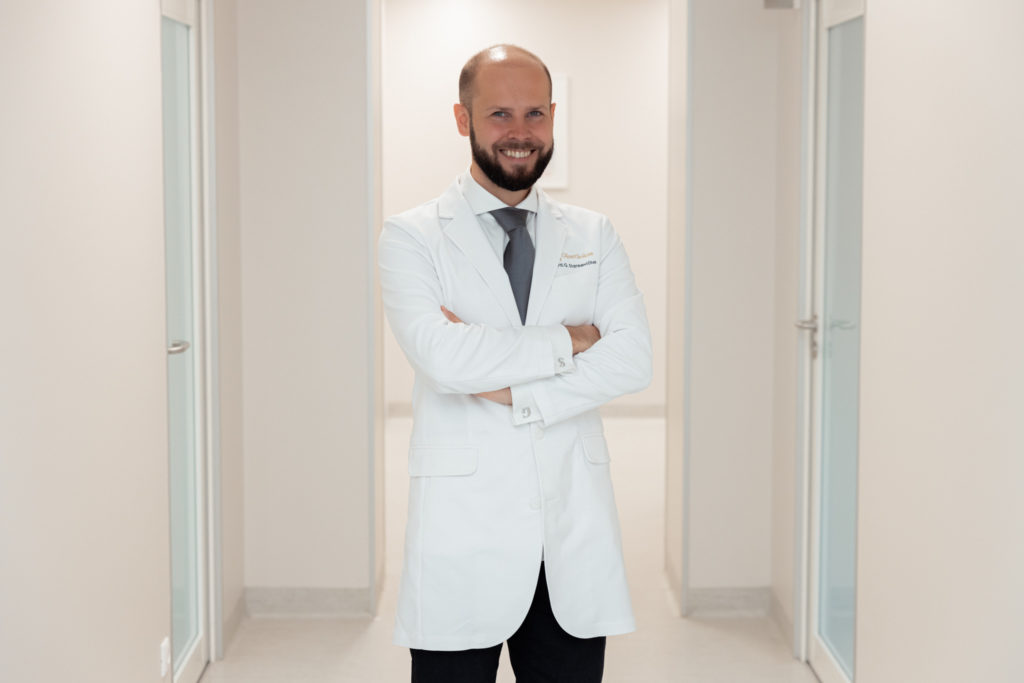
Beautiful breasts after breastfeeding – mission possible
Motherhood changes a woman's physique, particularly her breasts. Women believe this is because of prolonged nursing, however, this is not the case. We shall refute several myths regarding maternity and breast attractiveness in this article.
Myth 1. The longer I breastfeed, the more my breasts will collapse
Women note that their breasts shrink after breastfeeding that their previous bras become too large, and that bra straps no longer lift the breasts. Of course, there are workarounds, such as silicone inserts in the bra or purchasing push-up bras, but this does not solve the problem. Women then comfort themselves that their sacrifice (loss of breast attractiveness) by saying, “After all, I have been breastfeeding for so long!” And occasionally joke that “this baby has gobbled me up”, leaving only the sacks instead of my breasts.
Medics have the answer to these thoughts – it is not breastfeeding that changes the breasts. So, what is driving these changes? As soon as a woman becomes pregnant, her hormones begin to shift, which causes changes in her breasts. Here’s what happens:
• The breast gland tissue expands, while the adipose tissue shrinks.
• Hormones loosen the ligaments that keep the muscles together. It’s the nature’s technique of enabling the uterus to grow, but it also relaxes the muscular ligaments that keep the breasts together.
• The weight of the breasts is about doubled before giving birth. At the same time, the volume of the breasts and their surface area increase. So does the skin of the breasts.
So a woman may not be breastfeeding at all, but if she has been pregnant and given birth, the breasts may sag owing to excess skin and will already be different from girlish breasts.
Myth 2. Active sports will help me lift my breasts.
Fitness professionals advise all women to exercise both during and after pregnancy. Sport promotes blood circulation, improves muscular tone, mood, oxygen transmission to the foetus, and a thousand other things, but it does not lift the breasts. Certain workouts can only serve to … make your breasts even smaller.
Breasts sag and collapse after childbearing due to extra skin that can no longer flex, not muscular weakness. You may feel defeated after reading that; is there nothing that can be done? It is probably conceivable to make an attempt to limit breast changes. Because a lot depends on heredity, these suggestions will benefit some people more than others.
Here are some breast-saving tips:
• Wear comfortable bras that do not tighten but retain the breasts properly and securely during pregnancy and nursing. Breasts can double in size while nursing, which is difficult for the ligaments that hold the breasts together, which is why a breastfeeding bra should have broad shoulder straps.
• Wean your child gradually rather than abruptly. Weaning your child gradually permits the breast tissue to slowly recover.
• Remove the bra at night. Wearing a bra while sleeping affects lymph flow. Lying down changes the form of the breasts, and wearing a bra at night adds more compression. This is true not only during pregnancy and nursing, but also throughout the normal stages of a woman’s life.
• Avoid jumping activities (running, jumping rope, strenuous aerobics) when nursing since they will strain the breast-supporting ligaments that keep the breasts together even more.
• Massage oils into your breasts to enhance skin tone and help them shrink.
Myth 3. Breast changes after delivery are purely aesthetic problem.
Psychologists and physiotherapists are already scrambling to refute this notion. The latter will tell you that a woman’s posture, respiration, internal organs, and blood circulation are all affected by her chest position. However, it has an even stronger influence on a woman’s emotional condition. Breasts, after all, are a symbol of femininity and beauty. A woman sees a radically different image in the mirror after having children, which might cause her to develop a complex.
We all know that a happy mother is a happy family, so you can joke that the beauty of a woman’s breasts is a problem for the whole family.
Myth 4. Breast surgery is only for those who work on stage
The most reliable way to beautify the breasts is surgical correction. Occasionally, the press publishes articles about how actresses, singers and opinion leaders have had their breasts corrected. In reality, modern cosmetic surgery is so sophisticated and affordable that you don’t need to be a showgirl to have a breast lift.
We asked Gijos Klinikos plastic and reconstructive surgeon Giedrius Stankevičius to tell us about breast surgeries. We asked him the most often asked questions by women.

How long after giving birth must I wait before having a breast lift?
Breast surgery, and any other surgery in general, should not be conducted until 6 months after the end of breastfeeding. This is significant because nursing produces hormones that disrupt the healing process.
When a woman comes in for a consultation, we have a lengthy conversation in which I listen to what she wants, tell her what I can do to help her, when is the optimum time to have the surgery and how long the recovery process will take. After all, breast correction surgery can be as simple as a breast lift, as complex as a breast lift with implants, as simple as an implant augmentation, or as simple as a breast correction using your own fat. Often, it is only after a conversation with the doctor and a thorough examination that a decision is made.
Is it worthwhile to correct my breasts now if I still plan to have a baby in the future?
I always tell my patients that if they plan a family increase within the next five years, they should postpone the procedure. Breastfeeding is normally possible following such procedures, although there are exceptions. These are individual cases that should always be reviewed with your doctor before proceeding with surgery. I never perform surgery if, according to my professional judgement, it is not necessary.
Do breast corrections always require implants?
It is impossible to forecast what type of surgery will be required because each case is very individual, based on the woman’s body structure prior to pregnancy, the changes that happened in her body during pregnancy, and her post-pregnancy lifestyle. Implant augmentation is the most common type of breast surgery globally, yet the outcomes vary greatly depending on age group and region.
Implants are the first choice if the breasts were relatively small before the delivery, increased by several sizes during the feeding, and returned to their previous size after the feeding. A different situation is when a woman’s breasts are already quite large before pregnancy – then most of the time it is necessary to lift her breasts so that they take on a nice shape again.
Is it a difficult operation?
Each operation has unique characteristics, and I believe it would be unjust to categorise them based on difficulty. The operating time might vary based on the surgical plan (for example, if you are also getting an abdominal plastic surgery), the day of your cycle (menstrual periods have greater bleeding, which naturally prolongs the surgery), and, of course, the condition of the breasts.
The preparation for surgery is standard, but one factor is always critical – whether a woman smokes. If at all feasible, we always encourage women to abstain from smoking for at least one month before and after surgery. Smoking has a significant negative influence on the healing process. Every cigarette smoked delays healing by half an hour! Smoking affects the walls of blood vessels and alters collagen production, reducing skin suppleness and making it more difficult to achieve the desired result.
Incisions differ greatly depending on the type of treatment used. When we fill a woman’s breasts with her own fat, for example, the incision is barely noticeable. When breast augmentation with implants is performed, the size of the incision varies based on the incision location and the size of the implant.
Possible incision locations for breast lift surgery include: incision around the areola (the so-called “donut”); incision around the areola and a vertical incision (the so-called “lollipop”); incisions around the areola, vertical and horizontal (“ancor” in type). All these options are available together with the augmentation if the woman wants both a breast lift and augmentation.
It is usually recommended to get a preventative ultrasound check of the breasts on a regular basis, at least once a year. An ultrasound check is required if you observe changes in the form of your breasts a few years after implantation.

How long will I be unable to work following my surgery?
This is also highly personal, since each woman recovers at a different rate. The least troublesome healing is after fat transfer and breast augmentation. The woman’s activity is then restricted for 2–3 weeks. If implants are utilised in the procedure, the limits are more dependent on the woman’s job.
Women ask whether they must observe any limits following surgery, such as refraining from lifting weights or flying. The biggest restriction is no smoking. The main recommendations are: not to irrigate the wound (depending on the nature of the operation), not to engage in premature activity (depending on your doctor’s advice), avoid bathing, and contact the doctor who performed the operation if you have any questions about the post-operative course of the operation.
All the inconveniences fade quickly, following the surgery, the woman starts to enjoy her image in the mirror again, which is one of the most important motivations.